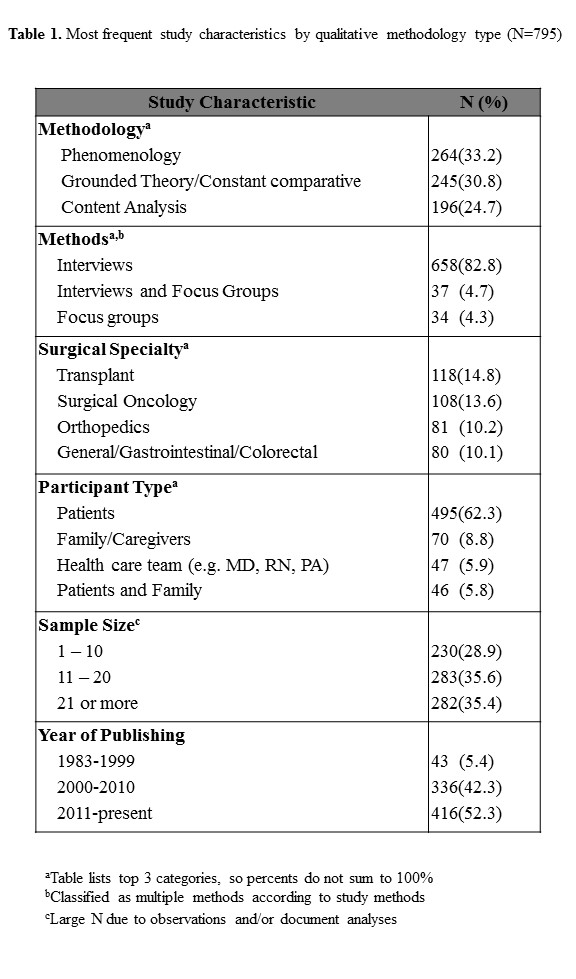A. C. Robinson1, J. R. Appelson1, N. R. Changoor1, W. A. Davis1, A. H. Haider1, M. A. Morris1 1Brigham And Women’s Hospital, Harvard Schools Of Medicine And Public Health,Department Of Surgery,Boston, MA, USA
Introduction:
Recently, researchers have recognized the need for qualitative research in surgery, because it offers a toolset to understand lived experiences and the influence of social context in the healthcare setting. However, few studies have described the current state of qualitative surgical research. The present study is a comprehensive literature scope of qualitative surgical research to identify: (a) common approaches to qualitative surgical research; (b) gaps in the literature to inform future qualitative inquiry.
Methods:
We searched PubMed using ‘surgery’ and 7 qualitative methodology search terms (Grounded Theory, Constant Comparative, Phenomenology, Content Analysis, Discourse Analysis, Case study, Ethnography). Exclusion criteria included: mixed-methodology, literature/systematic reviews, non-surgical studies, and non-English language studies. Extracted data included: methodology (e.g. grounded theory, case study), methods (e.g. interviews, observations), surgical specialty (e.g. transplant, surgical oncology) and participant population (e.g. patient, family, provider). Four researchers extracted study information for relevant abstracts, and a fifth researcher independently reviewed 10% of abstracts to determine inter-rater reliability.
Results:
A total of 2,017 articles were reviewed. After removing duplicates, 39.4% articles were deemed relevant (N=795; κ = 0.74). The most common methodologies included: phenomenology (33.2%), grounded theory/constant comparative method (30.8%), and content analysis (24.7%). The most common approaches were interviews (82.8%) conducted with patients (62.3%). Sample sizes varied widely within methodologies (mean: 27, range: 1-797). The most common surgical specialties were transplant (14.8%) and surgical oncology (13.6%). Overall, 36.4% of studies were published in nursing journals, and 9% in surgical journals. Fewer than half of studies were published before 2011, thus over half have been published in just the last four years (52.3%).
Conclusions:
Our results suggest that qualitative surgical research is gaining in popularity despite the majority of relevant studies being published in non-surgical journals. Notably, nearly two-thirds of studies utilized only two of the seven methodological approaches (grounded theory and phenomenology). Further surgical qualitative research should take advantage of a greater variety of approaches to provide insight into rare phenomena and social context. For example, qualitative inquiry can inform complex issues, such as health disparities and training needs that are relevant to the increasingly diverse patient and healthcare professional populations.
